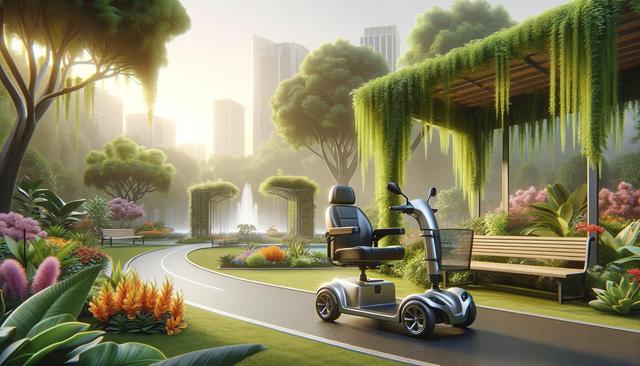
A Practical Guide to Mobility Scooters for Seniors
Understanding Mobility Scooters and Their Purpose
Mobility scooters are personal transportation devices designed to assist individuals with limited mobility, particularly seniors. These battery-powered scooters offer a convenient way to move around both indoors and outdoors without the physical strain of walking long distances. As people age, maintaining independence becomes increasingly important, and mobility scooters provide a practical solution for those who want to stay active and engaged in their daily lives.
These scooters vary in size, design, and functionality, allowing users to choose a model that fits their specific needs. Whether it’s a compact scooter for maneuvering tight indoor spaces or a durable model designed for outdoor use, there’s an option that can accommodate different lifestyles and mobility challenges. The key advantage is the ability to regain freedom of movement, which can have a positive impact on both mental and physical well-being.
Mobility scooters are especially beneficial for seniors dealing with conditions such as arthritis, balance issues, or joint pain. By reducing the need for walking unassisted, they help prevent fatigue and minimize the risk of falls. As a result, seniors can continue participating in social activities, running errands, or simply enjoying time outside without relying on others for assistance.
Types of Mobility Scooters for Seniors
There are several types of mobility scooters available, each catering to different mobility needs and environments. Understanding the distinctions can help in selecting the right model for personal use.
- Travel Scooters: Lightweight and portable, these are ideal for short trips and can be disassembled to fit in a car trunk.
- Three-Wheel Scooters: Designed for better maneuverability in tight spaces, suitable for indoor use or smooth outdoor surfaces.
- Four-Wheel Scooters: Offer enhanced stability and are better suited for outdoor use, particularly on uneven terrain.
- Heavy-Duty Scooters: Built for higher weight capacity and longer use, these are designed for users needing extra support and durability.
Each type of scooter comes with its own set of features such as adjustable seating, storage baskets, and different battery ranges. Seniors should consider how and where they plan to use the scooter most often to ensure the model they choose aligns with their lifestyle and mobility requirements.
Key Considerations Before Purchasing
Choosing the right mobility scooter involves more than just picking a model. Seniors and their caregivers should evaluate a range of factors to make an informed decision. Comfort, safety, portability, and battery life are among the essential aspects to review.
Here are some key considerations:
- Weight Capacity: Ensure the scooter can safely accommodate the user’s weight.
- Terrain Compatibility: Consider whether the scooter will be used on sidewalks, indoors, or on rougher outdoor surfaces.
- Storage and Transport: If the scooter needs to be transported in a car, check for foldable or disassemblable models.
- Battery Range: Longer battery life is beneficial for users who plan to use the scooter frequently or for extended periods.
- Seat Comfort and Adjustability: A padded, adjustable seat can greatly improve the user experience, especially for longer rides.
It’s also wise to test different scooters before purchasing, either through a local mobility store or a rental service. This allows seniors to get a feel for the controls, turning radius, and overall comfort. Consulting with a healthcare provider or occupational therapist can also provide valuable insights into which features are most important for individual needs.
Cost and Insurance Considerations
The cost of mobility scooters can vary widely depending on type, brand, and features. Basic models may be more affordable, while heavy-duty or specialized scooters generally come at a higher price. For seniors on a fixed income, understanding the financial aspect is crucial.
Here’s a general breakdown of potential costs:
- Basic Travel Scooters: Lower-priced and often suitable for light, occasional use.
- Mid-Range Scooters: Offer a balance between comfort and performance, suitable for daily use.
- Advanced or Heavy-Duty Scooters: Higher-end models with advanced features, built for frequent or long-distance use.
Some insurance providers or government assistance programs may cover part or all of the cost, especially if a medical need is demonstrated. It’s important to check with the relevant agencies and health insurance companies to understand what documentation is required and what expenses are eligible for reimbursement. Warranty coverage and maintenance plans should also be reviewed to avoid unexpected costs later on.
Staying Safe While Using a Mobility Scooter
Safety is a major concern when using mobility scooters, especially for seniors with limited reflexes or vision issues. While these devices are generally safe, responsible use and proper handling can prevent accidents and ensure a smooth experience.
Here are some safety tips for scooter use:
- Practice Before Regular Use: Spend time getting familiar with the controls, speed settings, and turning capabilities.
- Use Designated Paths: Stick to sidewalks, ramps, and marked paths to avoid uneven surfaces and traffic areas.
- Avoid Overloading: Don’t exceed the scooter’s weight capacity or carry items that may affect balance.
- Keep the Battery Charged: Regular battery checks help avoid being stranded unexpectedly.
- Wear Visible Clothing: Bright or reflective clothing can improve visibility when riding outdoors.
Routine maintenance is also essential. Checking tire pressure, brakes, and battery condition ensures that the scooter remains in good working order. Many manufacturers recommend periodic servicing, which can be done through certified repair centers. Encouraging seniors to treat their scooter like any other vehicle—with attention to safety and upkeep—can go a long way in extending its usability and reliability.
Conclusion: Enhancing Senior Independence
Mobility scooters are a valuable tool for seniors seeking to maintain their independence and enjoy everyday activities with ease. With various models and features available, there’s a suitable option for almost every need and lifestyle. By understanding the different types, evaluating practical considerations, and following safety guidelines, seniors can confidently choose a mobility scooter that supports their mobility goals.
For older adults, these scooters are more than just transportation devices; they are instruments of freedom and social connection. Whether it’s visiting friends, shopping, or simply enjoying a ride in the park, mobility scooters enable seniors to remain active participants in their communities. With thoughtful selection and responsible use, they can be a lasting investment in comfort, safety, and quality of life.


